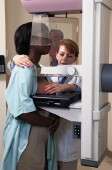Rapid expansion of mammography screening at a Veterans Affairs facility has translated to increased clinical volumes and increased time to definitive treatment, according to research published online Sept. 18 in JAMA Surgery.
(HealthDay)—Rapid expansion of mammography screening at a Veterans Affairs (VA) facility has translated to increased clinical volumes and increased time to definitive treatment, according to research published online Sept. 18 in JAMA Surgery.
Charlotte L. Kvasnovsky, M.D., from the Baltimore Veterans Affairs Medical Center, and colleagues retrospectively analyzed all breast cancer cases treated from Jan. 1, 2000, to May 31, 2012, at the Baltimore VA Medical Center facility. Process-of-care metrics were compared before and after 2008, when programmatic changes were implemented.
The researchers found that during the study period a total of 7,355 mammograms were performed and 76 patients with breast cancer received treatment. The majority of mammograms (6,720) were performed after 2008, with a median of 1,453 mammograms performed annually and 6.33 patients treated for cancer annually after 2008. This represents 1,200 percent and 49 percent increases, respectively, compared with the 2000 to 2007 interval. Thirty-four days was the interval between screening mammography and tissue diagnosis, with no significant difference between study intervals, while the time from tissue diagnosis to initiation of definitive treatment increased from 33 to 51 days between 2008 and 2012. Breast conservation therapy was received by 33 eligible patients (67.3 percent), while 16 patients (32.7 percent) underwent mastectomy.
"Our data suggest that as patient volumes increase with intensified screening, VA hospitals may benefit from acquiring a full complement of on-site breast care services rather than improving flow between VA hospitals and non-VA breast care centers having specialized resources," Kvasnovsky and colleagues conclude.
Several authors disclosed financial ties to the Veterans Health Administration.
More information:
Abstract
Full Text (subscription or payment may be required)
Journal information: JAMA Surgery
Copyright © 2013 HealthDay. All rights reserved.



















